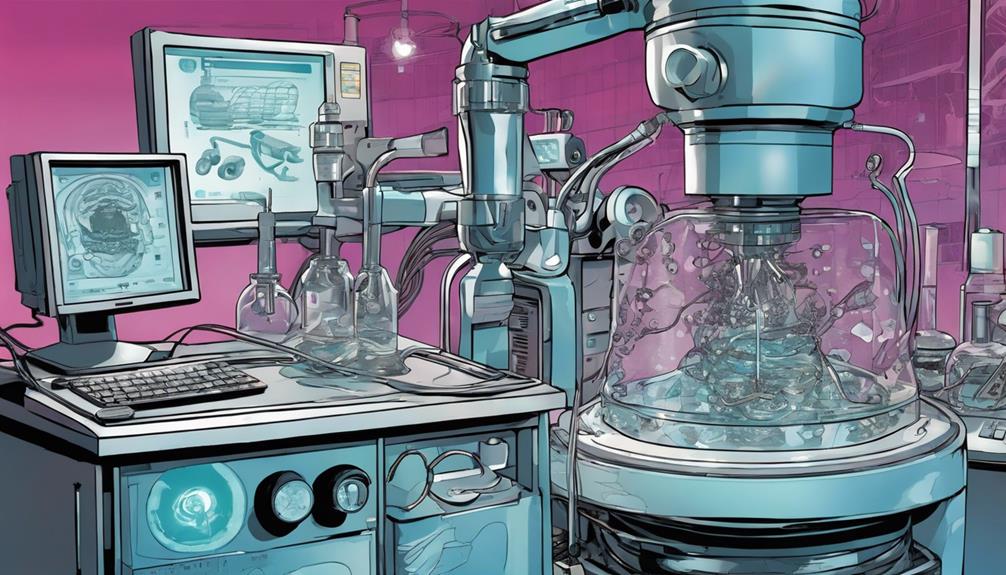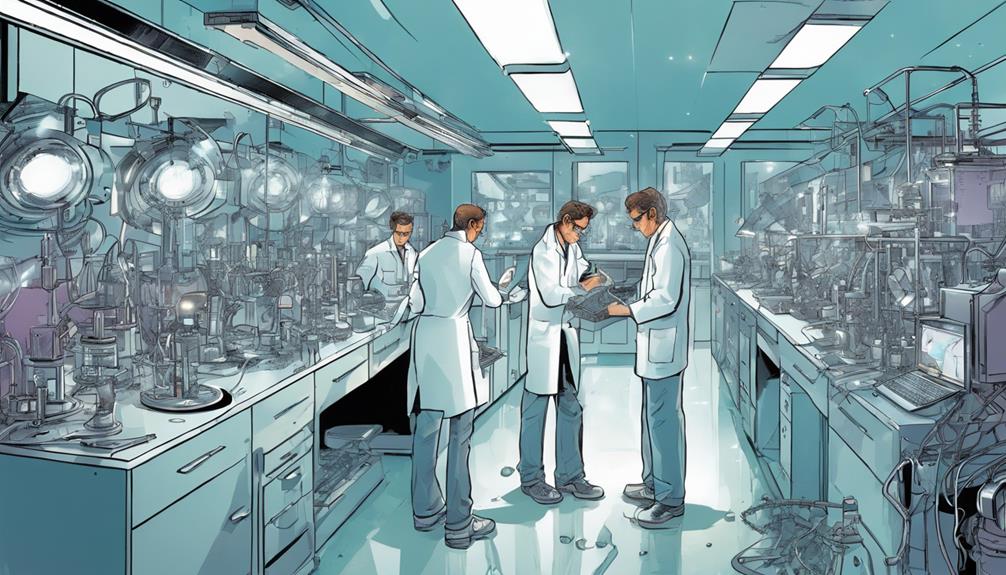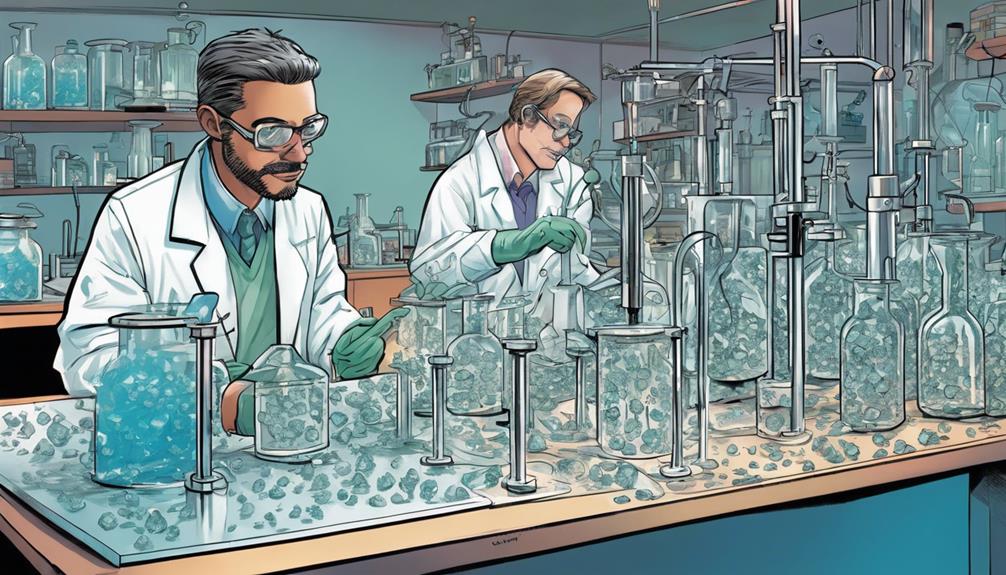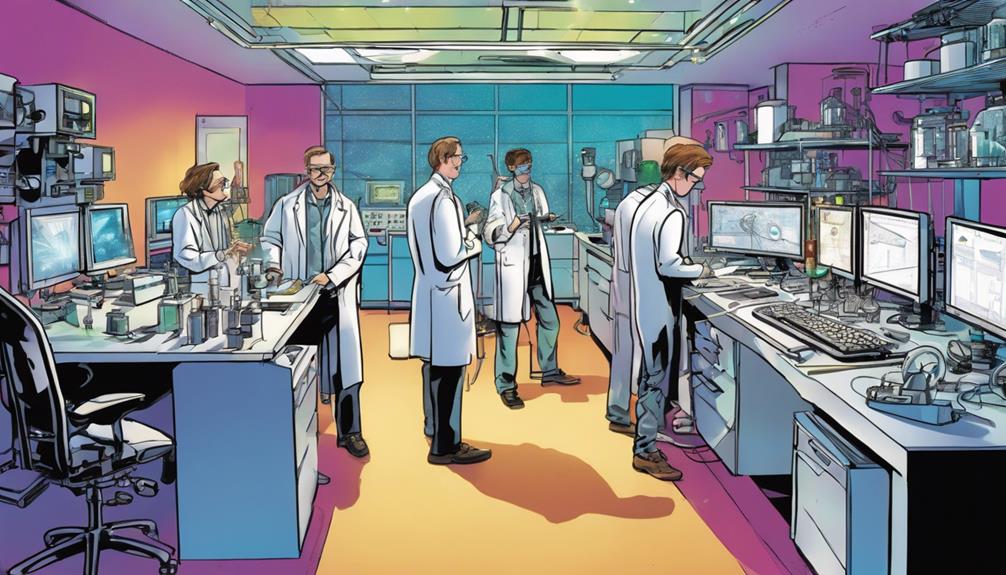Article Contents
- 1 Key Points
- 2 Chemical Vapour Deposition (CVD)
- 3 High Pressure High Temperature (HPHT)
- 4 Microwave Plasma Technology
- 5 Laser Technology in Diamond Formation
- 6 Ultrasonic Cavitation Method
- 7 Flux Growth Techniques
- 8 Scanning Tunneling Microscopy
- 9 Electrochemical Deposition
- 10 Seed Crystal Development
- 11 Advanced Optical Spectroscopy
- 12 Frequently Asked Questions
- 13 Conclusion
The leading technologies for creating lab-grown diamonds are Chemical Vapor Deposition (CVD) and High Pressure High Temperature (HPHT), known for their ability to produce diamonds with exceptional clarity and vibrant colours. These methods are complemented by Microwave Plasma Technology and Laser Technology, which refine the quality of the diamonds.
The Ultrasonic Cavitation Method and Electrochemical Deposition contribute to precise control over diamond growth. Advanced Optical Spectroscopy and Scanning Tunneling Microscopy ensure that each diamond meets strict standards of purity and structural integrity.
Finally, Seed Crystal Development and Flux Growth Techniques maintain the distinctiveness and quality of each diamond. Together, these technologies represent the forefront of sustainable and precise diamond manufacturing.
Key Points
- Chemical Vapour Deposition (CVD) creates layers of diamond by introducing carbon-rich gases in a controlled environment, enhancing the gem's clarity and quality.
- High Pressure High Temperature (HPHT) replicates the natural geological conditions found deep within the Earth, producing diamonds with rich colours.
- Microwave Plasma Technology facilitates the customisation of diamond properties, ensuring ethical production by reducing environmental impact.
- Laser Technology is employed to cut diamonds with exceptional precision, resulting in uniquely shaped diamonds with high clarity.
- Ultrasonic Cavitation Method utilises sound waves to precisely control the formation of diamonds, promoting sustainable practices in diamond manufacturing.
Chemical Vapour Deposition (CVD)
Chemical Vapour Deposition (CVD) is a widely used method for creating synthetic diamonds through controlled, layer-by-layer crystallisation. In this process, a diamond seed is exposed to a carbon-rich gas environment. The carbon atoms from the gas are deposited onto the seed, gradually forming a diamond crystal. This technique allows for precise management of the diamond's growth, resulting in stones with fewer impurities and exceptional clarity.
CVD diamonds have a variety of uses beyond traditional jewellery. Their consistency and purity make them suitable for high-precision optical devices and electronics, where conventional diamonds may not be suitable. The versatility of CVD technology also enables its application across different industries, underscoring its importance in contemporary diamond manufacturing.
Embracing CVD technology facilitates the availability of diamonds, offering consumers more options and supporting sustainable and ethical production methods. This approach combines artistic and scientific innovation, creating adaptable and visually appealing diamonds.
High Pressure High Temperature (HPHT)
High Pressure High Temperature (HPHT) is a well-established method for producing synthetic diamonds, replicating the intense conditions found deep within the Earth where natural diamonds originate. This technique involves subjecting carbon to high pressure and temperatures, closely mirroring the natural diamond formation environment. HPHT not only facilitates the creation of diamonds but also improves their quality, yielding gems with excellent clarity and vivid colours that often surpass natural diamonds in terms of uniformity and structural integrity.
HPHT diamonds are renowned for their exceptional durability and brilliance, making them highly desirable in the jewellery industry. These diamonds possess the same physical, chemical, and optical properties as those mined from the Earth, rendering them indistinguishable from natural diamonds to the unaided eye.
Furthermore, the process of growing diamonds through HPHT is considered more ethical and sustainable than traditional mining methods. This aspect makes HPHT diamonds an attractive choice for consumers who prioritise both aesthetics and ethical considerations in their purchases. As such, HPHT is a significant advancement in gemology, promoting both high-quality gem production and environmental and ethical responsibility.
Microwave Plasma Technology
Microwave Plasma Technology enhances synthetic diamond production through its sophisticated use of microwave energy in the Chemical Vapor Deposition (CVD) process. This method effectively ionises gas molecules with microwave radiation, creating a plasma state essential for diamond formation. The precise control of this plasma environment enables accurate adjustments of energy levels and chemical conditions, crucial for the crystalline structure development in diamonds.
The technology not only facilitates the customisation of diamond properties to meet specific needs but also ensures uniform crystal growth, significantly improving both the quality and consistency of the lab-grown diamonds. Its efficiency and control stand out, promoting sustainable and ethically responsible diamond production. This aspect is increasingly important to consumers today who value both innovation in design and ethical considerations in their purchases.
Laser Technology in Diamond Formation
Moving from microwave plasma technology, we now explore the use of laser technology in creating lab-grown diamonds.
This technique involves precise laser cutting to shape diamonds, ensuring high clarity and detailed designs tailored to sophisticated preferences.
Utilising lasers enhances the clarity of diamonds, maintaining their luxurious appeal and uniqueness.
Laser Precision Cutting Techniques
Laser precision cutting is crucial in the production of lab-grown diamonds, enhancing their brilliance and clarity. This advanced technology allows for exact cuts that improve the diamond's light reflection and dispersion, crucial for its sparkle.
The process meticulously optimises the facets to boost the diamond's aesthetic appeal. Moreover, laser cutting enables the customisation of jewellery, allowing designers to craft unique, detailed designs that meet individual tastes.
The consistency and accuracy of laser cuts ensure high-quality results and offer designers the flexibility to express creativity in each piece, making every creation a symbol of elegance and personal style.
Enhancing Clarity With Lasers
Laser technology significantly enhances the clarity of lab-grown diamonds by meticulously removing tiny internal imperfections. This process not only improves the aesthetics of the diamonds but also optimises their light performance, resulting in gems of exceptional brilliance and visual appeal.
With advanced laser techniques, manufacturers can consistently produce diamonds that are nearly flawless, ensuring both the quality and the reliability of the end product. This application of lasers in diamond processing ensures that each stone meets high standards of clarity and brilliance, making them highly desirable in the market.
Ultrasonic Cavitation Method

Transitioning from laser-based techniques, the ultrasonic cavitation method offers an innovative alternative for diamond synthesis.
This technique employs high-frequency sound waves to precisely control both the nucleation and growth stages of diamond formation.
We will discuss the critical equipment required, evaluate the process's efficiency, and assess the quality of the diamonds produced, providing insights into its practicality and applicability in modern gemology.
Process Overview
The Ultrasonic Cavitation method uses high-frequency sound waves to create the ideal conditions for the formation of lab-grown diamonds. This innovative technique ensures precise control over the environment, resulting in diamonds of exceptional quality and uniformity. The process not only provides a sustainable and ethical alternative to mined diamonds but also enhances consumer choice in the luxury market.
| Aspect | Benefit |
|---|---|
| Ultrasonic Control | Precise environment for diamond formation |
| Diamond Quality | Uniform, high-quality crystals |
| Engineering Precision | Optimal conditions for growth |
| Crystal Uniformity | Consistent size and clarity |
| Sustainability | Environmentally friendly and ethical |
This approach not only transforms diamond production but also aligns with modern values by offering an eco-friendly option without compromising on the quality or beauty of the diamonds.
Key Equipment Used
The Ultrasonic Cavitation method utilises specific equipment to optimise the production of lab-grown diamonds. This equipment is critical for managing growth conditions and enhancing efficiency. Here is a detailed overview of the main components involved:
- Ultrasonic Generators: These are crucial for producing the high-frequency sound waves necessary for initiating the cavitation process.
- Transducers: These devices transform electrical energy into ultrasonic energy, allowing precise control over the intensity and focus of the energy applied.
- Cavitation Reactors: The diamond growth takes place in these reactors, which are engineered to endure the extreme conditions of the process.
- Control Systems: These systems regulate temperature, pressure, and chemical parameters to maintain optimal conditions for diamond synthesis.
- Pressure Vessels: Designed to withstand the high pressures involved in the synthesis process, these vessels are integral to maintaining the structural integrity of the system.
This equipment works in a cohesive manner to ensure the efficient and reliable production of high-quality lab-grown diamonds, adhering to standards of semantic accuracy, completeness, consistency, conciseness, relevance, interoperability, and trustworthiness.
Efficiency and Outcome
Ultrasonic cavitation significantly improves the efficiency and quality of synthetic diamonds by precisely controlling pressure and temperature during the growth process. This method employs high-frequency sound waves to create an optimal environment for crystal growth, thus enhancing the formation rate and quality of the diamonds.
The increased energy from this process not only accelerates diamond synthesis but also yields diamonds with enhanced clarity and purity, qualities that are highly valued in the gemstone market. By adjusting ultrasonic cavitation settings, labs can better manage the growth process, leading to faster and more reliable production of high-quality diamonds.
This advancement has transformed synthetic diamond manufacturing, making it more efficient and effective.
Flux Growth Techniques

Flux growth techniques are used in the creation of lab-grown diamonds, not in the high-pressure high-temperature (HPHT) process, but as a separate method that involves dissolving carbon sources in a metal flux to aid diamond formation around a seed crystal. These methods demonstrate precision and control in diamond production, enabling the creation of gems that combine artistic quality with scientific accuracy.
- Controlled Growth: Ensures that each diamond grows under conditions optimised for both structural purity and integrity.
- Precise Crystallisation: Allows for the creation of diamonds with precise geometric shapes, essential for excellent light reflection and brilliance.
- Quality Assurance: Maintains high consistency in the physical and optical properties of the diamonds, similar to those of natural diamonds.
- Customisation Options: Provides the flexibility to produce diamonds tailored to aesthetic preferences and practical requirements.
- Sustainability: Offers an environmentally friendly alternative to traditional mining by reducing the dependence on natural diamond extraction.
These flux growth techniques represent a significant advancement in gem production, promoting a balance between technological innovation and ecological responsibility. The ability to craft flawless, bespoke diamonds sustainably supports modern ethical standards and contributes to responsible consumption.
Scanning Tunneling Microscopy
Scanning Tunneling Microscopy (STM) is vital for examining atomic structures on the surfaces of laboratory-grown diamonds. It plays a crucial role in improving the understanding of material properties and advancing surface analysis techniques. Using a fine tip, STM scans across the diamond surface, measuring the tunneling current to reveal detailed atomic configurations. This high-resolution method is key in enhancing the quality and appearance of laboratory-grown diamonds.
| Aspect | Impact on Lab-Grown Diamonds | Emotional Value |
|---|---|---|
| Surface Detail | Identifies microscopic flaws | Assurance of quality |
| Material Insight | Deepens understanding of diamond properties | Trust in craftsmanship |
| Precision | Improves growth processes | Pride in technological advancement |
STM's role in diamond synthesis ensures that each lab-grown diamond is nearly flawless, combining beauty with state-of-the-art technology. This meticulous focus on the creation process enhances both the aesthetic and functional characteristics of the diamonds, benefiting producers and consumers alike. This blend of precision and innovation paves the way for a future where superior quality and technological excellence go hand in hand.
Electrochemical Deposition

Electrochemical deposition is a technique used to aid the controlled growth of lab-grown diamonds by layering carbon atoms onto a diamond seed substrate. This method relies on precise electrochemical reactions to ensure each diamond develops consistently, with distinct characteristics like clarity, colour, and carat size tailored for cosmetic and technical uses.
Key aspects of electrochemical deposition comprise:
- Controlled Diamond Properties: Allows for precise adjustment of diamond features to meet specific market demands.
- Scalability: Suitable for large-scale manufacturing, effectively meeting the rising need for ethically sourced diamonds.
- Production Efficiency: Reduces waste and energy consumption, providing a more sustainable option compared to traditional diamond mining and synthetic production methods.
- Surface Quality Assurance: Examines and guarantees excellent surface quality standards for the manufactured diamonds.
- Optimised Growth Rates: Boosts production efficiency by optimising growth conditions, thus speeding up production schedules while maintaining high quality.
Electrochemical deposition not only promotes environmental sustainability but also gives consumers greater choices, moving away from the constraints imposed by the scarcity of natural diamonds. This method is dependable as it consistently produces high-quality diamonds and can adapt to specific consumer preferences.
Seed Crystal Development
Building on electrochemical deposition techniques, seed crystal development is crucial for the controlled growth of synthetic diamonds. The process starts with selecting a high-quality diamond seed, which acts as a template for the diamond's crystal structure. The quality of the seed crystal significantly affects the physical and aesthetic properties of the final diamond, such as clarity and colour.
Advanced techniques in seed crystal development ensure the replication of desired traits and optimise growth, allowing the production of diamonds that adhere to high-quality standards. The seed crystal's role is critical as it dictates the formation of the diamond, ensuring that each layer conforms to the intended structure. The controlled conditions enhance the seed's capabilities, resulting in synthetic diamonds that often match or exceed the quality of natural diamonds.
Advanced Optical Spectroscopy

Advanced optical spectroscopy is vital for carefully analysing and verifying the characteristics of laboratory-grown diamonds, with a specific focus on purity, colour, and clarity. This technology plays a crucial role in today's gemmological field, where precision and accuracy are paramount. By using spectral analysis, gemmologists can evaluate the distinct optical features of these artificial gems to ensure they meet strict quality and authenticity standards.
- Spectral Signature Matching: This process involves comparing how light interacts with laboratory-grown diamonds to that of their natural counterparts to confirm their authenticity.
- Purity Assessment: This analysis helps to identify any flaws and chemical inclusions that could impact the visual appeal and structural integrity of the diamond.
- Colour Grading: This technique determines the exact colour category of a diamond, which is essential for its valuation.
- Clarity Analysis: This examination identifies and measures any internal and external imperfections, which are crucial for accurately grading diamonds.
- Composition Insights: This offers detailed information on the material properties of diamonds, aiding in further research and enhancement of laboratory-grown varieties.
Frequently Asked Questions
What is the best method for lab-grown diamonds?
The most effective technique for producing lab-grown diamonds is the HPHT (High Pressure High Temperature) method. This method is highly regarded for its reduced environmental impact and compliance with sustainability trends. Furthermore, it eliminates the dependency on natural diamond extraction.
What Equipment Is Needed to Make Lab-Grown Diamonds?
To manufacture lab-grown diamonds, necessary equipment includes High Pressure High Temperature (HPHT) presses, Chemical Vapor Deposition (CVD) reactors, and sophisticated monitoring systems for quality control. Regular maintenance of this equipment and strict adherence to safety standards are essential to ensure operational efficiency and worker safety.
What is used to make lab-grown diamonds?
Lab-grown diamonds are produced using gases such as methane and hydrogen in highly controlled environments that replicate the conditions under which natural diamonds form. This method not only bypasses the need for mining but also ensures the ethical creation of diamonds.
How do you produce lab-grown diamonds?
Lab-grown diamonds are produced by recreating the conditions under which natural diamonds are formed. Techniques such as Chemical Vapor Deposition (CVD) and High Pressure High Temperature (HPHT) are used to grow these diamonds in controlled environments that imitate the natural growth processes, guaranteeing that their chemical composition is like that of natural diamonds. This technology offers a sustainable option to conventional diamond mining and also enables the customisation of diamond characteristics, which is attractive to individuals who value ethical and environmental factors in their buying decisions.
Conclusion
In summary, the technologies discussed represent a significant advancement in the production of lab-grown diamonds, combining historical techniques with contemporary scientific methods.
Technologies such as Chemical Vapor Deposition and Microwave Plasma demonstrate a dedication to eco-friendly luxury and are shaping the future of gemology.
As these methods continue to develop, they expand access to what were once exclusive luxuries, making high-quality diamonds available to a wider audience.
This progress not only promotes sustainability but also preserves the integrity and beauty associated with traditional diamond gems.

